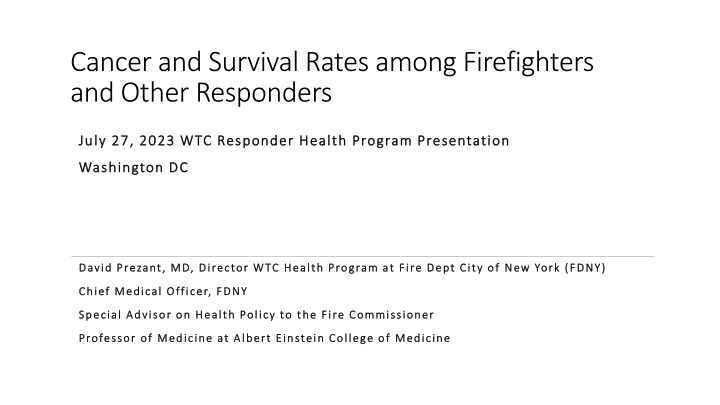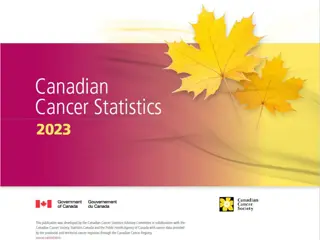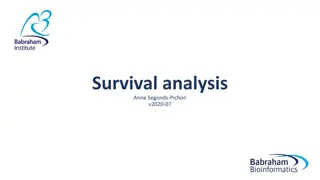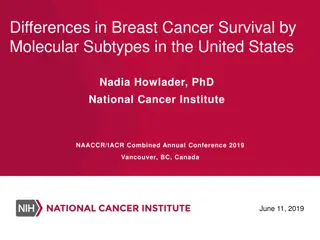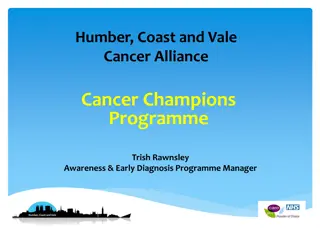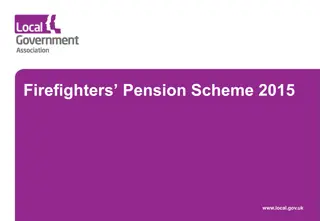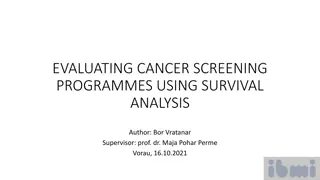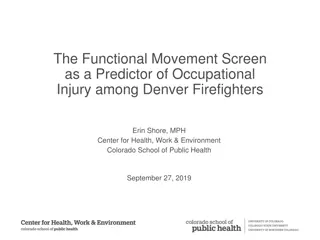Cancer and Survival Rates among Firefighters and Responders Study
Investigate cancer prevalence and mortality rates in WTC-exposed and career firefighters to differentiate impacts of exposures. Collaboration aims to understand health effects among cohorts.
Download Presentation

Please find below an Image/Link to download the presentation.
The content on the website is provided AS IS for your information and personal use only. It may not be sold, licensed, or shared on other websites without obtaining consent from the author.If you encounter any issues during the download, it is possible that the publisher has removed the file from their server.
You are allowed to download the files provided on this website for personal or commercial use, subject to the condition that they are used lawfully. All files are the property of their respective owners.
The content on the website is provided AS IS for your information and personal use only. It may not be sold, licensed, or shared on other websites without obtaining consent from the author.
E N D
Presentation Transcript
Cancer and Survival Rates among Firefighters and Other Responders July 27, 2023 WTC Responder Health Program Presentation July 27, 2023 WTC Responder Health Program Presentation Washington DC Washington DC David Prezant, MD, Director WTC Health Program at Fire Dept City of New York (FDNY) David Prezant, MD, Director WTC Health Program at Fire Dept City of New York (FDNY) Chief Medical Officer, FDNY Chief Medical Officer, FDNY Special Advisor on Health Policy to the Fire Commissioner Special Advisor on Health Policy to the Fire Commissioner Professor of Medicine at Albert Einstein College of Medicine Professor of Medicine at Albert Einstein College of Medicine
WTC Health Program and the Career Firefighter Health Study Collaboration between FDNY, Chicago, Philadelphia and San Francisco Joint Labor-Management-Government (NIOSH) Initiative We know that cancer rates are increased in the cohorts and also know there is a high prevalence of other chronic conditions Aims Identify prevalence and mortality rates in WTC exposed firefighters and in career firefighters from Chicago, Philadelphia and San Francisco Provide a more appropriate comparison control group for WTC firefighter studies Thereby differentiating the impact of WTC exposure from usual firefighter exposures Accounting for the Healthy Worker Effect on Mortality Reducing the impact healthcare disparities, access and possibly surveillance bias Investigators include: Robert D Daniels, Charles B Hall, David G Goldfarb, David J Prezant,, Joke Salako, Ankura Singh, Suzanne Triplett, Mayris P Webber, and Rachel Zeig-Owens
WTC & Career Firefighter Health Study Cancer Results WTC vs. Non WTC vs. Non- -WTC WTC Male non-FDNY, non-WTC- exposed firefighters actively employed on 9/11/2001 3 City Fire Departments Male WTC-exposed FDNY firefighters actively employed on 9/11/2001 3 Cities = San Francisco, Chicago & Philadelphia Total N Age on 9/11, mean SD Race/ethnicity, N (%) Non-Hispanic White Non-Hispanic Black Hispanic Othera Smoking status, N (%) Current Former Never WTC exposure/site arrival time, N (%) Morning of 9/11 Afternoon of 9/11 9/12/2001 9/13-9/24/2001 After 9/24/2001 Deceased by 12/31/16, N (%) Follow-up years, mean SD Total follow-up years A Includes Asian and Native American race categories; B N=10,723 who self-reported smoking status; C N=2,856 who completed Career Firefighter Health Study survey 10,786 40.4 7.5 8,813 43.9 9.2 10,121 (93.8) 282 (2.6) 353 (3.3) 30 (0.3) 6,117 (69.4) 1,589 (18.0) 736 (8.3) 371 (4.2) 19,599 Firefighters employed on 9/11/2001 373 (3.5)b 3,233 (30.2)b 7,117 (66.4)b 189 (6.6)c 1,056 (37.0)c 1,611 (56.4)c Note: throughout this presentation We only include males due to low numbers of females. Next phase should enable their inclusion 1,741 (16.1) 5,683 (52.7) 1,873 (17.4) 1,315 (12.2) 174 (1.6) 261 (2.4) 15.2 1.1 163,583.4 605 (6.9) 14.9 2.0 130,971.0
WTC & Career Firefighter Cancer Results vs US Males Standardized Incidence Ratios (SIRs) of cancers in male WTC-exposed and non-WTC-exposed firefighters vs. US males Non-WTC-exposed firefighters 3 City = San Francisco + Chicago + Philadelphia Fire Observed case count WTC-exposed FDNY Observed case count Site SIR 95% CI SIR 95% CI All cancer sitesab 915 1.15 (1.08-1.23) 1,002 1.05 (0.98-1.12) Prostate 332 1.70 (1.53-1.88) 358 1.22 (1.11-1.35) Lung 44 0.53 (0.39-0.72) 83 0.71 (0.57-0.89) Kidney 39 0.93 (0.67-1.28) 55 1.19 (0.90-1.56) Non-Hodgkin Lymphoma 55 1.39 (1.06-1.83) 43 1.04 (0.77-1.41) Melanoma (skin) 96 1.59 (1.30-1.96) 70 1.39 (1.07-1.79) Thyroid 46 2.37 (1.78-3.17) 15 1.01 (0.61-1.67) aAll malignant cancers (multiple primaries), and in situ bladder cancers; bExcludes non-melanoma skin cancers
WTC & Career Firefighter Health Study Cancer Results WTC vs. Non WTC vs. Non- -WTC Incidence Rates WTC Incidence Rates We compared incidence rates in FDNY WTC-exposed male firefighters to incidence rates to the non-WTC-exposed male firefighters (CFD, PFD, SFFD) FDNY WTC-exposed vs 3 City Fire Departments all non-exposed Webber et al, 2021 Data through 2016 All cancers 1.13 (1.02-1.25) RR (95% CI) Thyroid 2.53 (1.37-4.70) Prostate 1.39 (1.19-1.63) Lung 0.87 (0.57-1.33) Skin Melanoma 1.12 (0.80-1.57) WTC-exposed male firefighters had significantly higher rates of cancers especially thyroid and prostate compared to Non-WTC male Firefighters Ref: Webber et al OEM 2021
WTC & Career Firefighter Health Study Cancer Results WTC vs. Non WTC vs. Non- -WTC Incidence Rates WTC Incidence Rates For cancers diagnosed between 9/11/01 and 12/31/2016 WTC-exposed FDNY male firefighters had higher rates of cancer (15%) when compared with similar US males. Site-specific cancers that were statistically elevated include: Thyroid, Prostate, Melanoma, and Non-Hodgkin Lymphoma Lung cancer was significantly decreased WTC-exposed FDNY male firefighters had higher rates of cancers (13%) when compared with Non-WTC male Firefighters from the 3 collaborating cities Site-specific cancers that were statistically elevated include: Thyroid and Prostate
WTC & Career Firefighter Health Study Cancer Results WTC and Non WTC and Non- -WTC vs. US Male Mortality Rates WTC vs. US Male Mortality Rates Both WTC-exposed and non-exposed male firefighters had lower than expected all- cause mortality compared with US males. Standardized Mortality Ratios (SMRs) of all-cause and cause-specific mortality in male WTC-exposed FDNY and PFD firefighters vs. US males active on 9/11/2001 FDNY 3 city Cause of death (NIOSH major category) N SMR 95% CI N SMR 95% CI All causes 261 0.30 0.26-0.34 191 0.64 0.55-0.73 All cancers 86 0.40 0.32-0.49 32 0.45 0.31-0.63 Heart diseases 52 0.27 0.20-0.35 62 0.72 0.55-0.92 Cancer incidence in WTC-exposed and non-exposed male firefighters, compared with the US adult male population: 2001-2016. Occup Environ Med. 2021 Oct;78(10):707-714 All-cause and cause-specific mortality in a cohort of WTC-exposed and non-WTC-exposed firefighters. Occup Environ Med. 2023 Mar 27:oemed-2022-108703. doi: 10.1136/oemed-2022-108703
WTC & Career Firefighter Health Study Results WTC and Non WTC and Non- -WTC vs US Male Mortality Rates WTC vs US Male Mortality Rates Table 2: Standardized Mortality Ratios (SMRs) of all-cause and cause-specific mortality in male WTC-exposed FDNY and non-WTC-exposed non-FDNY firefighters vs. US males, 9/11/2001-/12/31/2016 FDNY count All causes 261 0.30 3 City count 605 3 City SMR 0.60 Cause of death FDNY SMR 95% CI 95% CI 0.26-0.33 0.55-0.65 All cancer Oral cancer Digestive cancer Respiratory cancer Male genital cancer Kidney or bladder cancer Other/unspecified cancer Blood cancers 86 1 37 12 4 3 15 14 0.40 0.15 0.54 0.19 0.54 0.25 0.40 0.74 0.32-0.49 0.07-0.36 0.43-0.68 0.08-0.44 0.28-1.02 0.13-0.50 0.30-0.53 0.39-1.38 206 0.73 0.65 0.65 0.63 0.91 1.01 0.87 1.03 0.65-0.83 0.25-1.70 0.53-0.80 0.55-0.74 0.60-1.39 0.66-1.54 0.66-1.15 0.80-1.33 5 57 55 12 15 37 25 Diabetes Heart diseases Other circulatory diseases Respiratory diseases Digestive diseases Intentional self-harm (suicide) 4 0.14 0.27 0.18 0.31 0.13 0.36 0.06-0.35 0.21-0.34 0.10-0.31 0.22-0.42 0.06-0.28 0.20-0.65 14 120 24 36 24 31 0.38 0.51 0.38 0.57 0.42 1.01 0.27-0.53 0.43-0.59 0.25-0.57 0.45-0.72 0.29-0.61 0.76-1.34 52 8 14 8 17
WTC & Career Firefighter Health Study Cancer Results WTC vs. Non WTC vs. Non- -WTC Mortality Rates WTC Mortality Rates We compared mortality rates in WTC-exposed firefighters to rates in non-WTC-exposed firefighters Cause of death All causes Adj. RR (95% CI) 0.54 (0.49-0.59) All cancers 0.72 (0.65-0.79) Diseases of the heart Diseases of the respiratory system Diseases of the digestive system Other injury 0.61 (0.55-0.67) 0.69 (0.62-0.77) 0.54 (0.48-0.60) 0.90 (0.81-1.01) Ref: Singh A et al OEM 2023
WTC Responder Combined Cohort Collaboration between FDNY World Trade Center Program, General Responder Cohort WTC Health Program, WTC Health Registry, NYS DOH Joint Labor-Management-Government (NIOSH) Initiative Primary research question: Impact of WTC exposure & the WTC Health Program on WTC Responder (rescue/recovery workers) Mortality Rates Investigators included: Charles Hall, Paolo Boffetta , Robert Brackbill, James Cone, Chris Dasaro, Mark Farfel, David Goldfarb, Amy Kahn, Dana Kristjansson, Jiehui Li, David Prezant, Baozhen Qiao, Maria Schymura, Moshe Shapiro, Ankura Singh, Andy Todd, Janette Yung, and Rachel Zeig-Owens
WTC Responder Cohort Overlap Total: 69,134 WTC Responders: Fire, EMS, Police, Construction, etc 9,845 (14%) in more than one cohort
WTC Responder All Cause & Cancer Survival WTC-MMTP vs NYS WTC-non-MMTP vs NYS HR 0.93 (95% CI 0.79-1.10) HR 0.64 (95% CI 0.58-0.72) WTC-MMTP vs NYS WTC-non-MMTP vs NYS HR 0.94 (95% CI 0.78-1.14) HR 0.72 (95% CI 0.64-0.82) WTC-MMTP = WTC Health Program WTC-non-MMTP = WTC Health Registry NYS = NYS State residents, same age, sex & same cancer Ref: Goldfarb, Zeig-Owens et al AJIM 2021
WTC Responder Cancer Survival WTC Health Program enrollees with any cancer WTC Health Program enrollees with prostate cancer WTC Health Program enrollees with colon cancer 52% fewer deaths 38% fewer deaths 36% fewer deaths
Longer Survival in WTC Health Program Responders (FDNY & GRC) compared to NYS population with same cancer WTC MMTP vs. NYS non-responders All-cause Mortality by cancer site HR (95%CI) NYS Prostate 0.62 (0.44, 0.88) WTC MMTP (n=2,037) non-responders (n=574,075) Lung and bronchus 0.74 (0.56, 0.97) Esophagus 0.65 (0.36, 1.18) Deaths n (%) 303 (14.9) 224,040 (39.0) Colon and rectum 0.48 (0.31, 0.74) Cancer deaths n (%) 248 (12.2) 158,645 (27.6) Survival rate n (%) Myeloma 0.49 (0.22, 1.10) 1-year survival 1,916 (94.1) 474,895 (82.7) Pancreas 1.66 (1.15, 2.39) 3-year survival 1,346 (88.3) 326,959 (69.6) Brain and other nervous system 1.11 (0.70, 1.76) 5-year survival 919 (86.1) 228,933 (62.8) Liver 0.74 (0.44, 1.22) Melanoma of the skin 0.54 (0.27, 1.08) Kidney and renal pelvis 0.36 (0.16, 0.79) Follow-up time starts at diagnosis date, males only, adjusted for age and date of diagnosis Combining Three Cohorts of WTC Rescue/Recovery Workers for Assessing Cancer Incidence and Mortality. Int. J. Environ. Res. Public Health. 2021 Cancer survival among WTC Rescue/Recovery Workers: a collaborative cohort study. Am J Ind Med. 2021
Summary: WTC & Career Firefighter Health Study: WTC-exposed vs Non-WTC exposed Confirms that Cancer rates are increased and that this is driven by specific types/sites Not just a healthy worker effect Cancer and All-cause Mortality is lower in FDNY WTC firefighters than other career firefighters WTC Responder Combined Cohort Study: Confirms that Cancer rates are increased and that this is driven by specific cancer types/sites Cancer and All-cause Survival benefit from being in the WTC Health Program
Published Peer Published Peer- -Reviewed Medical Studies Reviewed Medical Studies Combining Three Cohorts of WTC Rescue/Recovery Workers for Assessing Cancer Incidence and Mortality. Int. J. Environ. Res. Public Health. 2021 Cancer survival among WTC Rescue/Recovery Workers: a collaborative cohort study. Am J Ind Med. 2021 Cancer incidence in WTC-exposed and non-exposed male firefighters, compared with the US adult male population: 2001-2016. Occup Environ Med. 2021 Oct;78(10):707-714 All-cause and cause-specific mortality in a cohort of WTC-exposed and non-WTC-exposed firefighters. Occup Environ Med. 2023 Mar 27:oemed-2022-108703. doi: 10.1136/oemed- 2022-108703
